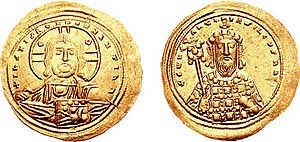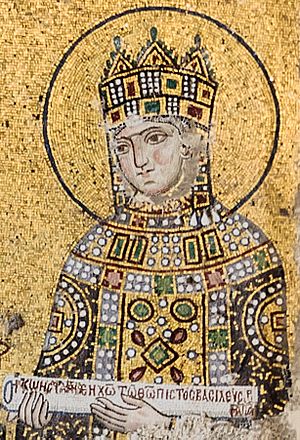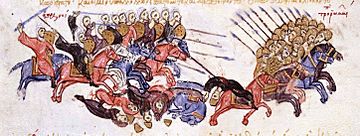Romanos III Argyros facts for kids
Quick facts for kids Romanos III Argyros |
|
|---|---|
| Emperor and Autocrat of the Romans | |

Romanos III, from the Madrid Skylitzes
|
|
| Byzantine emperor | |
| Reign | 12 November 1028 – 11 April 1034 |
| Coronation | 15 November 1028 |
| Predecessor | Constantine VIII |
| Successor | Michael IV and Zoë |
| Co-regent | Zoë |
| Born | 968 Hierapolis, Thracesian Theme, Byzantine Empire (now Pamukkale, Denizli, Turkey) |
| Died | 11 April 1034 (aged 65/66) Constantinople, Byzantine Empire (now Istanbul, Turkey) |
| Spouse | Zoë Porphyrogenita |
| Dynasty | Macedonian/Argyros |
Romanos III Argyros (Greek: Ρωμανός Γ΄ Αργυρός; Latinized as Romanus III Argyrus; 968 – 11 April 1034) was a Byzantine Emperor from 1028 until his death. He was a noble and high-ranking official in Constantinople. When Emperor Constantine VIII was dying, he arranged for Romanos to marry his daughter Zoë. Romanos became emperor just three days later, after Constantine's death.
Romanos III is remembered as an emperor who meant well but struggled to be effective. He made changes to the tax system and weakened the army. He even led a military trip against Aleppo that did not go well. He also had disagreements with his wife and faced challenges to his rule. He spent a lot of money building and fixing churches and monasteries. He died after ruling for six years and was succeeded by Michael IV.
Contents
Who Was Romanos III?
Early Life and Family
Romanos Argyros was born in 968. He came from the important Argyros family. His grandfather was the son of another Romanos Argyros. This earlier Romanos had married Agatha, who was a daughter of Emperor Romanos I Lekapenos (who ruled from 919 to 944).
Romanos III had several brothers and sisters. His brother Basil Argyros was a general and governor. Another brother, Leo, died in Italy in 1017. His sister Pulcheria married a high-ranking official named Basil Skleros. Another sister married Constantine Karantenos, who was a governor of Antioch. His sister Maria Argyropoulina married Giovanni Orseolo, the son of the Doge of Venice.
His Career Before Becoming Emperor

Romanos started his career as a krites, which means a judge, in a region called Opsikion. He held a high judicial rank called protospatharios. In this role, he worked to stop certain religious groups in Akmoneia. Later, he was promoted to quaestor. This was a very important judicial role for the capital city, Constantinople. He also became one of the judges of the Hippodrome, which was the highest court in the empire.
He was then promoted to the rank of patrikios and became the administrator of the Great Church. He continued to oversee the High Court. Under Emperor Constantine VIII, Romanos became the urban prefect of Constantinople. This made him the official head of the Senate and one of the emperor's main helpers.
Becoming Emperor

In late 1028, Emperor Constantine VIII was very ill and close to death. He wanted to make sure his family, the Macedonian dynasty, would continue to rule. Since he had no son, he first called for Constantine Dalassenos to marry his oldest daughter, Zoë. Dalassenos was a strong military leader and a loyal noble.
However, the emperor's advisors did not want a powerful military figure to become the next emperor. They convinced Constantine VIII to choose Romanos instead. They thought Romanos would be easier to influence. So, Emperor Constantine VIII arranged for Romanos to marry Zoë. Romanos was 60 years old, and Zoë was 50. The wedding happened on November 12, 1028. This was the same day Constantine VIII died. Romanos was crowned emperor three days later.
Romanos III's Time as Emperor
The new emperor wanted to be a great ruler. He admired Marcus Aurelius, a famous philosopher king, and also wanted to be a strong military leader like Trajan. He spent a lot of money on new buildings and on supporting churches and monasteries.
Romanos tried to reduce taxes for the wealthy nobles. However, this hurt the government's finances. Earlier emperors had tried to limit the power of the nobles over common people. But Romanos, being from a noble family himself, stopped this policy. This allowed the nobles to take advantage of the farmers, who became more like serfs (people tied to the land). This also weakened the army, which traditionally recruited soldiers from these farmers. Less money and fewer local soldiers caused problems for the empire in the long run.
Military Campaigns
In 1030, Romanos decided to lead his army against the Mirdasids of Aleppo. Even though they had agreed to be under Byzantine rule, Romanos wanted to show his power. The campaign did not go well. The army camped in a dry area, and their scouts were attacked. A Byzantine cavalry attack failed. Romanos decided to end the campaign and return home. He even ordered his siege machines to be burned.
On August 10, 1030, the army left its camp. There was a lot of disorder among the soldiers. The Emir of Aleppo then attacked, and the imperial army quickly ran away. Only the emperor's personal guards, the Hetaireia, stayed strong. Romanos himself was almost captured. After this defeat, the army was seen as a "laughing-stock."
Despite this loss, the Emir of Aleppo later negotiated a treaty. Aleppo became a tributary (meaning it paid money) to the Byzantine Empire. A Greek governor was also allowed to be in the city. In 1032, the Byzantine general George Maniakes successfully defended Edessa. Also, a Saracen fleet was defeated in the Adriatic. These victories helped a little, but Romanos's popularity did not fully recover.
His Legacy and Death
Romanos faced some challenges to his rule, often involving his sister-in-law, Theodora. In 1029, she was involved in a plan to take the throne. The plot was discovered, and the prince involved was blinded. Theodora was not punished at that time. In 1031, she was involved in another plan and was sent to a monastery.
To save money, Romanos limited his wife Zoë's spending. This made their relationship worse. Romanos died on April 11, 1034. His death was sudden. He was buried in the Church of St. Mary Peribleptos, a church he had built.
On the same day Romanos III died, Zoë married Michael. The next day, they asked the Patriarch Alexios I to crown Michael as the new emperor. After some hesitation, the Patriarch agreed, and Michael IV became the new emperor of the Romans.
See also
 In Spanish: Romano III para niños
In Spanish: Romano III para niños


